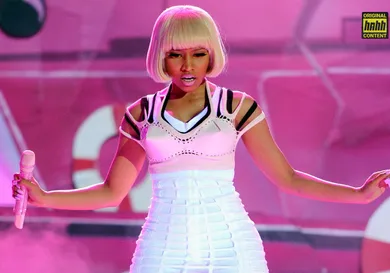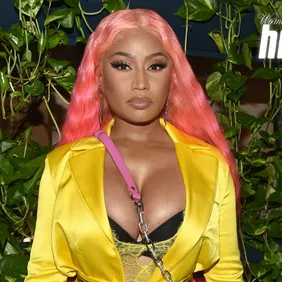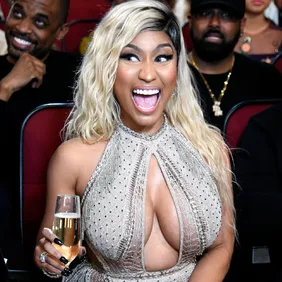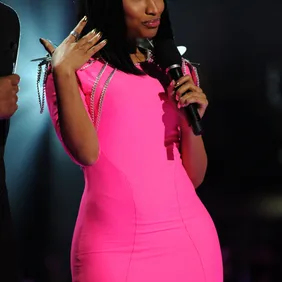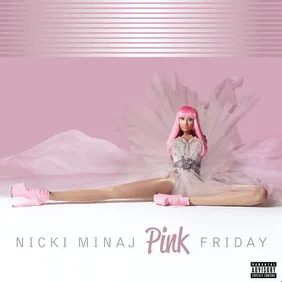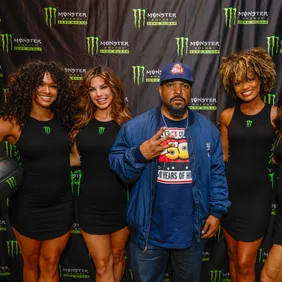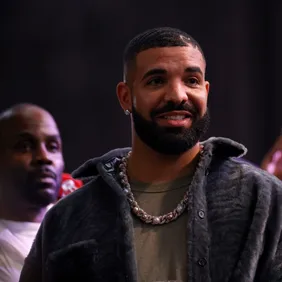Nicki Minaj has molded and maintained her own lane over the past decade. She’s undeniably elevated as Young Money’s First Lady, making a name for herself as the queen of New York City and developing a dedicated mass of Barbz that will jump at any given opportunity to defend her status. Despite the commentary that’s been circulating about her falling off, and the weird shots she took at Travis Scott and his daughter Stormi for not having the number one album, rap history of the 2010s cannot be written without her name. When she announced her retirement officially in August, after teasing her exit on Chance the Rapper’s “Zanies & Foolies,” Barbz or not, Twitter erupted in shock. But in a recent interview with The Shade Room she doubled back on her sentiments, clarifying that while she won’t be recording a fifth studio album, she’ll still be releasing features. And arguably, that’s where she shines the most.
Nicki Minaj and Lil Wayne attend the Grammys, 2011 - Jason Merritt/Getty Images
Nicki Minaj’s music had extraterrestrial life far before Safaree started dancing to it. Circling back to the 2009 release of Beam Me Up Scotty, every Funkmaster Flex drop was necessary to emphasize the clean cut bars she packed on each track when she began to flood the radio. As she prevailed in the Mecca of hip-hop a decade ago, one key component separated her from every other rapper in the five boroughs: her animation. New York City rap has always been known for its grit, and while Nicki possessed that, her almost pleasantly childish approach created her peak of undeniable significance. She called herself a Barbie, and rapped alike with high pitch ad-libs, alter egos, and prep school type delivery. In songs like “Roger That,” the music video is reflected in the style of a comic book, demonstrating bars in the form of onomatopoeia’s; that’s exactly how Nicki rapped. Aside from Young Money, she easily began to dominate songs with her verses and visuals, rotating fluorescent wigs, snapping her neck in kooky costumes, and scrunching her face like she was sipping on vinegar, seen and heard in Ludacris’ “My Chick Bad.” Almost immediately, she proved that she could hold her own with legends, but 2010 was just the start.
Nicki Minaj and Ludacris performing together, 2010 - Bryan Bedder/Getty Images
If you told any hip-hop head back in 2010 that Nicki Minaj would be on a song with Kanye West, JAY-Z, and Rick Ross, and have the best verse, they probably would’ve laughed. But trust, there is no cap in that statement. Nicki’s verse on “Monster” was heroic, symbolizing her rise to the top of the rap game but more importantly, proving that she could effortlessly hold her own on a track with music’s biggest names. Her verse was so strong that Kanye West even contemplated leaving it off of My Beautiful Dark Twisted Fantasy. But this wasn’t the first time she stole the show from her predecessors, and it quickly became something she was known for. In fact, at that point Nicki had already done it twice on Mariah Carey’s “Up Out My Face” and the remix of DJ Khaled’s “All I Do Is Win,” which featured Ludacris, Rick Ross, Snoop Dogg, and T-Pain. Around the industry, Kanye West probably wasn’t the only artist to be intimidated by her features. Who wants to get killed on their own song? But this idea transcended way past the realm of rap.
Nicki Minaj scrunches up her face as she performs at the 2010 BET Awards - Frederick M. Brown/Getty Images
Nicki Minaj continued her reign in the worlds of pop and R&B as well, cementing a Nicki Minaj feature as its own genre. She became a switch talent, extending her reach way past rap by teaming up with artists like Justin Beiber on “Beauty and a Beat” and Maroon 5 on “Sugar.” While it was widely known that her features posed as a threat in the rap game for their animation and quality, she began to gain even more fans outside of hip-hop by teaming up with the top artists in other genres. Whether she was on a pop radio, techno, or R&B song, the world beyond rap felt the impact of Nicki’s features. She eliminated the bar for herself, holding her own with legends in any genre while becoming one, in the same instance. Her solo efforts were a different story though. All four of her studio albums went platinum, but from Pink Friday to Queen, the numbers have dwindled down. Despite the fact that she became a rap superstar, it became hard for hip-hop heads to point any of her albums out as a certified classic. Her features were known for their intense grit, scrabble game wordplay, and pink polo style Kanye West word rhyming. Her projects as a whole weren’t nearly as consistent as her run of features. For someone who’s clearly affected by the charting and criticism of her studio albums, she’s fortunate enough to have another lane to lean on that also defines her legacy. If she continues her impressive guest verses, she’ll keep more control than streaming numbers and journalists can dictate.
The key difference between albums and mixtapes are the intentions. While mixtapes typically remain free in terms of creativity and price, albums are often formulated to recoup money fronted by record labels, forcing artists to drop songs that vie for radio play, but may be a disservice to the artist’s true craft. That seems to be the case with Nicki. For sure, she’s got some heaters on her studio projects. But when a song like “Super Bass” starts playing in the middle of an album, it disrupts the flow and creates some questionable moments in her discography. With Nicki Minaj continuing to give out guest verses, she’ll keep control of what she actually wants to put out as opposed to comprising with industry personnel. She can work with whomever she wants, whether it’s the classic Young Money linkups that have given us gems like “Up All Night” or putting on for artists who are up next like Megan Thee Stallion on “Hot Girl Summer” and 6ix9ine on “Fefe.” She can continue to bounce around music freely, upholding her tradition of outdoing people on their own songs while stealing their fans simultaneously. Her run has been nothing short of impressive. Realistically, it may even go down as the best in rap history. And considering the quality, it looks like we’re in store for more classic verses. The pressure will be minimized, presenting a hit-making cheat code that’s filled the decade with laughably intriguing lyrics and moments. If she did opt to keep dropping full-lengths, her albums would do numbers regardless, whether or not they debut at number one on the charts. However, with the continuance of her features, she’ll uphold the part of her legacy that’s nearly flawless.
